 W
WEudendriidae is a taxonomic family of hydroids (Hydrozoa). The family contains around 85 species.
 W
WHydrozoa are a taxonomic class of individually very small, predatory animals, some solitary and some colonial, most living in salt water. The colonies of the colonial species can be large, and in some cases the specialized individual animals cannot survive outside the colony. A few genera within this class live in fresh water. Hydrozoans are related to jellyfish and corals and belong to the phylum Cnidaria.
 W
WJellyfish and sea jellies are the informal common names given to the medusa-phase of certain gelatinous members of the subphylum Medusozoa, a major part of the phylum Cnidaria. Jellyfish are mainly free-swimming marine animals with umbrella-shaped bells and trailing tentacles, although a few are anchored to the seabed by stalks rather than being mobile. The bell can pulsate to provide propulsion for highly efficient locomotion. The tentacles are armed with stinging cells and may be used to capture prey and defend against predators. Jellyfish have a complex life cycle; the medusa is normally the sexual phase, which produces planula larva that disperse widely and enter a sedentary polyp phase before reaching sexual maturity.
 W
WThis list of prehistoric medusozoan genera is an attempt to create a comprehensive listing of all genera that have ever been included in the subphylum Medusozoa, excluding purely vernacular terms. The list includes all commonly accepted genera, but also genera that are now considered invalid, doubtful, or were not formally published, as well as junior synonyms of more established names, and genera that are no longer considered medusozoans.
 W
WActinulida are an order of hydrozoans in the subclass Trachylinae. Very small, medusoid Hydrozoa without polyp phase, living in the sand interstitial, solitary, bell entirely or very much reduced, epidermis ciliated, 1-2 whorls of tentacles, statocysts present or not, club shaped and derived of ecto- and entodermal tissue; cnidome may include stenoteles.
 W
WAegina citrea is a genus of hydrozoans in the family Aeginidae.
 W
WAequoreidae is a family of hydrozoans. There are approximately 30 known species found in temperate and tropical marine coastal environments. Aequoreids include Aequorea victoria, the organism from which the green fluorescent protein gene was isolated.
 W
WAglaophenia pluma, the toothed feather hydroid or podded hydroid, is a colonial hydroid in the family Aglaopheniidae and is found worldwide. It lives from the shore to 120m under water.
 W
WAplanulata is a suborder of Hydrozoa, a class of marine and freshwater invertebrates belonging to the phylum Cnidaria.
 W
WCampanularia is a genus of hydrozoans, in the family Campanulariidae.
 W
WCandelabridae is a small family of cnidarians within the class Hydrozoa. Myriothelidae Hincks, 1868 and Symplectaneidae Fraser, 1941 are now accepted as synonyms of this family.
 W
WCandelabrum capensis, or gnome's hat hydroid, is a species of sessile hydroid cnidarian. It is a member of the family Candelabridae.
 W
WCandelabrum tentaculatum, also called the dreadlocks hydroid or calamari hydroid, is a sessile marine hydroid, that is found off the Cape Peninsula of South Africa.
 W
WCapitata is a suborder of Hydrozoa, a class of marine invertebrates belonging to the phylum Cnidaria.
 W
WCorhiza scotiae, the fine hydroid, is a delicate colonial hydroid in the family Halopterididae.
 W
WCorymorphidae is a family of hydroid cnidarians. For long placed in a presumed superfamily or infraorder Tubulariida of suborder Capitata, they are actually close relatives of the Hydridae and are now united with these and a number of relatives in a newly recognized suborder Aplanulata. Most, if not all species in this family grow on stalks and resemble small flowers.
 W
WEctopleura is a genus of hydrozoans in the family Tubulariidae.
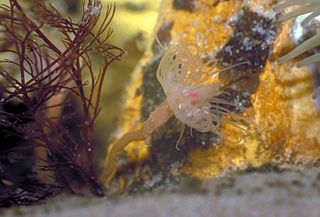 W
WEctopleura larynx, or ringed tubularia, is a hydroid in the family Tubulariidae.
 W
WFilifera is a suborder of hydrozoans in the order Anthoathecata. They are found in marine, brackish and freshwater habitats.
 W
WGattya humilis, the snowdrop hydroid, is a delicate colonial hydroid in the family Halopterididae.
 W
WGelenoptron tentaculatum is an extinct, cnidarian-like organism represented by a single specimen and counterslab from the Burgess Shale. The holotype of G. tentaculatum was originally identified as a second specimen of the Animalia incertae sedis, Redoubtia, but established as a separate genus by Simon Conway Morris in 1993. A reflective shield recalls the float of chondrophore hydrozoans.
 W
WThe grey fan hydroid is a large colonial hydroid in the family Solanderiidae.
 W
WHydroids are a life stage for most animals of the class Hydrozoa, small predators related to jellyfish.
 W
WHydroidolina is a subclass of hydrozoans in the phylum Cnidaria. It contains the bulk of the paraphyletic "Hydroida" which were one of the main groupings of the class Hydrozoa in older classifications and were placed at order rank. Hydroidolina also includes, however, the highly advanced colonial jellies of Siphonophora, which were not included in the "Hydroida".
 W
WLimnomedusae is an order of hydrozoans.
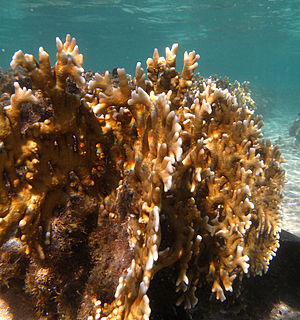 W
WMillepora tenera is a species of fire coral in the family Milleporidae. It is native to the Red Sea and the western Indo-Pacific region and is a zooxanthellate species with a calcareous skeleton. It was first described in 1949 by the Dutch zoologist Hilbrand Boschma.
 W
WMonobrachium is a genus of hydroids. These marine cnidarians form the only genus of the monotypic family Monobrachiidae.
 W
WMonobrachium is a genus of hydroids. These marine cnidarians form the only genus of the monotypic family Monobrachiidae.
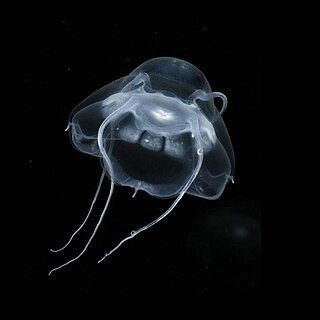 W
WNarcomedusae is an order of hydrozoans in the subclass Trachylinae. Members of this order do not normally have a polyp stage. The medusa has a dome-shaped bell with thin sides. The tentacles are attached above the lobed margin of the bell with usually a gastric pouch above each. There are no bulbs on the tentacles and no radial canals. Narcomedusans are mostly inhabitants of the open sea and deep waters. They can be found in the Mediterranean in large numbers.
 W
WPhialella is a genus of hydrozoans. It is the only genus within the monotypic family Phialellidae.
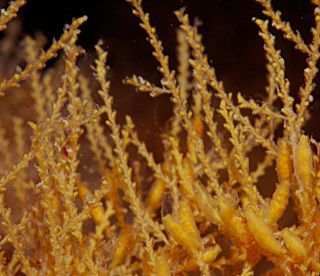 W
WThe planar hydroid is a branching colonial hydroid in the family Sertulariidae.
 W
WPlumularia setacea, the plumed hydroid or little sea bristle, is a colonial hydrozoan in the family Plumulariidae and is found worldwide. It lives from the shore to 430m under water.
 W
WScandia mutabilis is a species of hydroids of the family Hebellidae. It was first described in 1907 by James Ritchie from specimens obtained from Cape Verde. It also occurs in the Gulf of Mexico.
 W
WSertularella gayi is a branching colonial hydroid in the family Sertulariidae.
 W
WSertularella polyzonias is a branching colonial hydroid in the family Sertulariidae.
 W
WSertularia is a genus of hydroids in the family Sertulariidae.
 W
WSertulariidae is a family of hydrozoans.
 W
WSiphonophorae is an order of Hydrozoans, a class of marine organisms belonging to the phylum Cnidaria. According to the World Register of Marine Species, the order contains 175 species.
 W
WSolanderia is the sole genus of hydrozoans in the monotypic family Solanderiidae. They are commonly known as tree hydroids or sea fan hydroids.
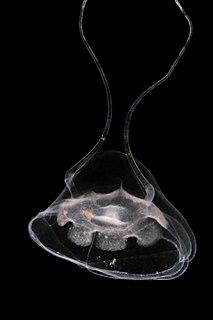 W
WSolmundella is a genus of hydrozoan in the family Solmundaeginidae. It is monotypic, with the single species Solmundella bitentaculata.
 W
WStylaster is a genus of hydroids in the family Stylasteridae.
 W
WStylaster nobilis, the noble coral, is a branching colonial hydroid in the family Stylasteridae.
 W
WStylasteridae is a family of hydrozoans.
 W
WThuiaria is a genus of hydroids in the family Sertulariidae.
 W
WThuiaria articulata, the jointed hydroid or sea spleenwort, is a branching colonial hydroid in the family Sertulariidae.
 W
WTrachylinae is a subclass of hydrozoans. It is placed at order rank in many older classifications, and limited to contain the Narcomedusae and Trachymedusae. But the Actinulidae, then considered an independent order, and probably also the Limnomedusae which were traditionally placed in the paraphyletic "Hydroida", belong to this group too. It is not entirely clear whether the Limnomedusae and the Trachymedusae as conventionally circumscribed are monophyletic
 W
WTrachymedusae belong to the phylum Cnidaria and the class Hydrozoa, among the 30 genera are 5 families containing around 50 species in all, the family Rhopalonematidae has the greatest diversity.
 W
WThe tubular hydroid is a species of hydroid cnidarian, and is found in temperate coastal waters. It is a member of the family Tubulariidae.
 W
WThe tubular sponge hydroid is a species of hydroid cnidarian. It is a member of the family Tubulariidae. These animals usually grow embedded in sponges.
 W
WTubulariidae is a family of hydroid cnidarians. For long placed in a presumed superfamily or infraorder Tubulariida of suborder Capitata, they are actually close relatives of the Hydridae and are now united with these and a number of relatives in a newly recognized suborder Aplanulata. Most if not all species in this family grow on stalks and resemble small flowers.